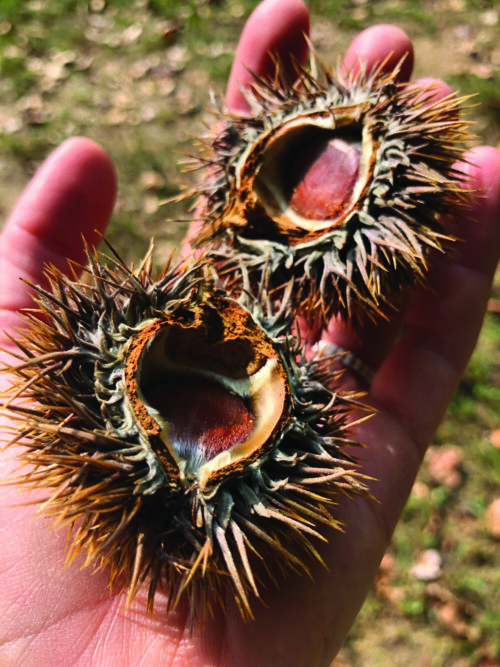By Jaime Vanderleuvenson, Michelle Baumflek, Tommy Cabe, Stacy Clark, Michael LaVoie

American-Chinese chestnut hybrid (Photo by Jaime Vanderleuvenson)
The Eastern Band of Cherokee Indians’ (EBCI) American chestnut restoration initiative is entering a phase of community outreach. The EBCI Natural Resources Department is currently working to implement restoration activities within Tribal forests―including the potential restoration of the American chestnut―and is looking for EBCI citizens’ input. The USDA Forest Service is also interested in EBCI citizens’ perspectives about chestnut restoration more broadly. These two entities are working together to reach as many EBCI citizens as possible with the goal of approaching American chestnut restoration on Aniyvwiyah (Cherokee) homelands in a way that reflects EBCI values.
American chestnut and the EBCI:
American chestnut has been a culturally significant tree for Aniyvwiyah for thousands of years and continues to be part of EBCI culture today (example, chestnut bread). However, much of Aniyvwiyah’s relationship with American chestnut has been altered through the loss of mature trees from the chestnut blight. Few people remember American chestnut before the blight, when it constituted one-quarter to one-half of the trees in the forest. The EBCI Natural Resources Department is hoping to connect with folks who have historical and contemporary viewpoints about American chestnut restoration.
Who is involved?
The EBCI Natural Resources Department partnered with the USDA Forest Service to fund an ORISE Fellow (Oak Ridge Institute for Science and Education) to assist with community outreach. The ORISE fellow is Jaime Vanderleuvenson (formerly, Van Leuven), who previously conducted the American chestnut survey of Tribal Reserve (Cherokee One Feather June 20, 2023). Jaime is working with the EBCI Natural Resources Department to engage EBCI citizens in reflecting on how American chestnut is important to the EBCI and sharing their perspective about how the EBCI Natural Resources Department should approach restoring this tree to the Qualla Boundary and within broader Aniyvwiyah homelands.
A team is advising Jaime with this work, including Tommy Cabe, EBCI Forest Resource Specialist, Mike LaVoie, EBCI Natural Resources Director, Michelle Baumflek, Forest Service Research Biologist, who has worked with the Tribe on culturally significant plants since 2016, and Stacy Clark, Forest Service Research Forester who specializes in American chestnut and white oak. Additionally, Tyson Sampson, EBCI Earth Keeper and Community Researcher, has been advising Jaime on how to be in respectful relationship with EBCI citizens.
Why restoration now and why your voice is important:
Since the chestnut blight in the early 1900s, American chestnut is considered “functionally extinct” on the landscape—meaning it is still present, but rarely able to grow large enough to produce nuts. This is why Chinese chestnuts have mostly replaced American chestnuts in the EBCI cultural food, chestnut bread (Chinese chestnuts are larger, but less sweet, so some sugar is often added). So, why are we talking about restoring American chestnut to the Qualla Boundary now? Because the methods the Natural Resources Department engages in could impact citizens’ relationship with this culturally significant plant.
Traditional plant breeding methods:
Organizations have been developing blight resistance in American chestnut trees for over 100 years. Since the 1980s, The American Chestnut Foundation has “backcrossed” trees with Chinese chestnut, creating hybrids that are as mostly American, but may have some blight resistance from the Chinese chestnut—these are the trees in the EBCI chestnut orchard (Cherokee One Feather Oct. 27, 2021 edition). Other organizations like The American Chestnut Cooperators’ Foundation, approach American chestnut restoration with only American chestnut trees.
Incorporating Genetically Modified Organisms:
In 2005, researchers at the State University of New York developed a transgenic tree (genetically modified or GMO), coined “Darling 58” which is genetically engineered with a wheat gene for blight resistance. Darling 58 is currently under regulatory review by the United States Department of Agriculture’s Animal and Plant Health Inspection Service (APHIS) to determine if Darling 58 poses risks to plant and animal health. The Environmental Protection Agency and the Food and Drug Administration have regulatory oversight of Darling 58 before it can be released into the wild. An APHIS approval will allow these trees to be available for planting in forests without restriction, including areas adjacent to or within the Qualla Boundary.
Aniyvwiyah stewardship of American chestnut:
Prior to the chestnut blight, Aniyvwiyah engaged in a reciprocal relationship with American chestnut for millennia. American chestnut provided nutrition for Aniyvwiyah while Aniyvwiyah provided ideal growing conditions for the trees to flourish. Some of these historic land stewardship practices could be integrated into the Natural Resources Department’s plans for stewarding EBCI forests for American chestnut.
How to get involved and share your voice:
Innovations in science and technology have made this a crucial time for hearing EBCI perspectives about American chestnut restoration. Share your perspective with the EBCI Natural Resources Department. What about American chestnut is important to you? What methods do you think should be employed to steward Aniyvwiyah homelands for American chestnut?
Jaime is hoping to connect with each of the community clubs to share information about the project and distribute optional surveys in which people can contribute their perspective. You can complete this survey now here (https://forms.gle/FmQ32iqt2fRMxrtL9).
Follow-up listening sessions will provide an opportunity for folks to engage in discussion about the project with their community. Places, dates, and times to be determined and will be announced on the EBCI Natural Resources Department’s Facebook page.
Contact Jaime or the EBCI Natural Resources Department directly with questions: jaime.vanleuven@usda.gov, 603-440-9812.



